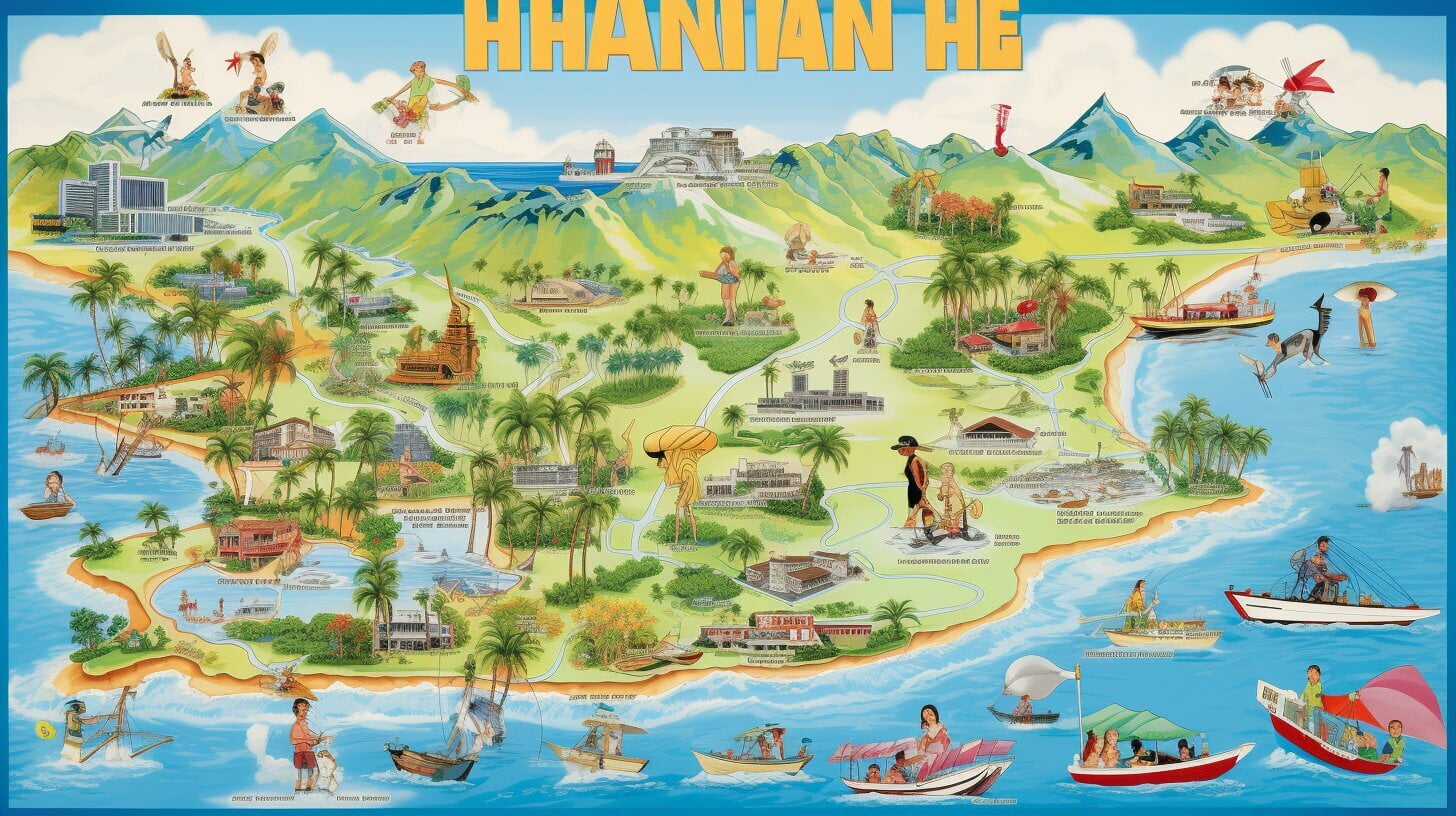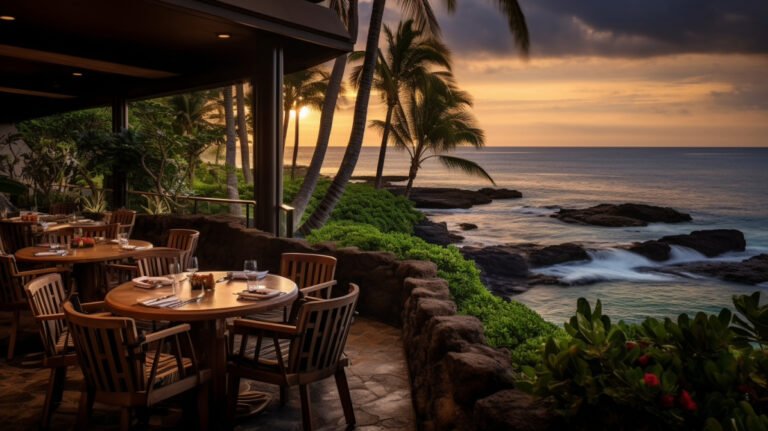Explore Hawaii’s Paradise: Your Ultimate Guide to Island Transportation 🏝️
In this comprehensive guide, we will provide you with all the necessary information and travel tips to navigate the transportation options available on the islands. Whether you’re planning to explore the stunning beaches, hike through lush rainforests, or visit cultural landmarks, having a reliable and efficient transportation plan is essential to make the most of your time in Hawaii.
Key Takeaways:
- Interisland flights are the most common mode of transportation between the Hawaiian islands, with frequent flights connecting the major airports.
- TheBus on Oahu is the most convenient and affordable public transportation option, while other islands have limited bus services.
- Renting a car is recommended for exploring beyond the main towns and resorts, with major car rental companies offering a variety of vehicles.
- Alternative transportation options like walking and biking can be eco-friendly ways to get around, especially in tourist resort areas.
- Remember to plan your transportation options in advance and consider factors like cost, convenience, and the specific attractions you want to visit.
With this guide, you’ll have all the information you need to easily navigate Hawaii’s transportation options, ensuring a stress-free and enjoyable vacation. Let’s dive in and start exploring the best ways to get around this beautiful island paradise!
The islands of Hawaii are connected by a network of interisland flights
The islands of Hawaii are connected by a network of interisland flights, making it easy to hop from one island to another. Whether you’re flying into Honolulu, Kahului, or one of the other major airports, there are plenty of options for getting around the islands.
The busiest airports for interisland flights are:
| Island | Major Airport |
|---|---|
| Oʻahu | Honolulu |
| Maui | Kahului |
| Hawaiʻi (Big Island) | Kona and Hilo |
| Kauaʻi | Lihuʻe |
There are also smaller airports that offer regular service, including Lanaʻi City (Lanaʻi), Kaunakakai and Kalaupapa (Molokaʻi), Kapalua and Hana (Maui), and Kamuela (Waimea) on the Big Island.
The main carrier for interisland flights is Hawaiian Airlines, which offers frequent flights on jets. Southwest also provides competition on the main routes, although their schedule is limited. For service to the smaller airports, Mokulele Airlines operates small prop planes that offer lower altitude flights, allowing for sightseeing opportunities.
Advance fares for interisland flights can be as low as $50, while walk-up fares are usually around $200. It’s important to note that regulations regarding oversized baggage, such as surfboards and bicycles, can vary between airlines and may be restrictive and costly.
Hawaii has only one interisland ferry route, a several-times-daily operation between Lahaina on Maui and Lanaʻi. It’s good for day trips as well as regular transport, although the Lahaina dock is not well served by public transit. Journeys often include sightings of dolphins and whales.
While there is an interisland ferry route between Maui and Lanaʻi, it is important to note that there are no other interisland ferry routes in Hawaii. Norwegian Cruise Line does operate seven-day cruises to the four largest islands, but these are round-trip voyages from Honolulu and individual segments between the islands cannot be booked.
If you prefer to use public transportation, Hawaii offers bus services on various islands, providing an affordable way to get around and explore the local attractions.
If you’re looking for a budget-friendly option to explore Hawaii, the public bus systems on the islands are a great choice. While public buses are available on multiple islands, the level of service and coverage varies.
Oahu: TheBus
When it comes to public transportation in Hawaii, Oahu stands out with its comprehensive bus system known as TheBus. TheBus offers convenient and affordable transportation throughout the island, making it easy to visit popular tourist spots and travel to and from Waikiki. With frequent service and an extensive route network, TheBus is a reliable way to get around Oahu.
Maui: Maui Bus
On the island of Maui, the public bus system known as Maui Bus provides transportation options for residents and tourists. While the coverage is not as extensive as Oahu’s TheBus, the Maui Bus is a convenient way to travel between the major towns and explore different parts of the island. However, it’s important to note that the Maui Bus does not run to Hana or Haleakalā National Park, so alternative transportation may be necessary for these destinations.
Big Island: Hele-On Bus
For those visiting the Big Island, the Hele-On Bus offers limited but essential transportation services. While the schedules may be less frequent and slower compared to other islands, the Hele-On Bus can still be utilized to get around and visit different towns on the island. However, it’s important to plan ahead and check the bus schedules to ensure that it aligns with your travel plans, as some routes may not operate on Sundays.
Kaua’i: Kauaʻi Bus
On the island of Kaua’i, the public bus system known as Kauaʻi Bus serves as a transportation option between the main towns. However, it’s important to note that the Kauaʻi Bus does not provide service to popular tourist destinations such as the Na Pali Coast, Waimea Canyon, or Kokeʻe State Park. Alternative transportation arrangements may be necessary to visit these attractions.
It’s always advisable to check the bus schedules and plan your trips accordingly, as public bus services in Hawaii may have limited operating hours and routes. Additionally, be prepared for longer travel times compared to private transportation options. However, using public buses can be a cost-effective way to explore Hawaii while enjoying the scenic views and immersing yourself in the local culture.
| Island | Bus Service |
|---|---|
| Oahu | TheBus |
| Maui | Maui Bus |
| Big Island | Hele-On Bus |
| Kaua’i | Kauaʻi Bus |
“Using public buses can be a cost-effective way to explore Hawaii while enjoying the scenic views and immersing yourself in the local culture.”
Renting a Car: The Best Option for Island Exploration
For those looking to explore beyond the main tourist spots, renting a car is the best option for easily getting around Hawaii and discovering hidden gems on each island. With a rental car, you have the freedom to create your own itinerary and go off the beaten path. Here are some key considerations and tips for renting a car in Hawaii:
Benefits of Renting a Car
Renting a car in Hawaii offers several advantages:
- Flexibility: Having a car allows you to explore at your own pace and visit remote areas that are not easily accessible by public transportation.
- Convenience: With a rental car, you can easily transport your luggage and gear, making it ideal for beach trips, hiking adventures, and shopping sprees.
- Accessibility: Many popular tourist attractions, such as scenic lookouts and natural wonders, are best reached by car.
Finding Affordable Rates
To find the best rates for car rentals in Hawaii, consider these tips:
- Book in advance: Prices tend to increase the closer you get to your travel dates, so make your reservation as early as possible.
- Compare prices: Use online travel agencies or car rental comparison websites to compare rates from different car rental companies.
- Look for discounts: Check for special promotions, loyalty programs, or membership benefits that can help you save on your rental car.
Recommended Car Rental Companies
When choosing a car rental company in Hawaii, consider the following reputable options:
| Car Rental Company | Website |
|---|---|
| Hertz | www.hertz.com |
| Avis | www.avis.com |
| Enterprise | www.enterprise.com |
| Alamo | www.alamo.com |
Renting a 4WD Vehicle for Off-Road Adventures
If you’re planning to explore the more rugged areas of Hawaii or venture off-road, consider renting a 4WD vehicle. This type of vehicle is suitable for navigating unpaved roads and accessing remote destinations. However, be sure to check with your rental car company about any restrictions or additional fees associated with off-road driving. It’s important to respect the local environment and follow any guidelines provided.
“Renting a car in Hawaii offers the freedom to create your own itinerary and explore hidden gems on each island.”
Exploring Hawaii by car allows you to immerse yourself in the stunning landscapes, visit local eateries, and discover lesser-known attractions. Just remember to plan your routes in advance, consider traffic patterns, and be aware of any parking restrictions or fees in popular areas. With a rental car, you can make the most of your Hawaiian adventure.
If you’re looking for a budget-friendly and eco-friendly way to get around Hawaii, consider walking or biking to explore the islands at your own pace.
If you want to experience the beauty of Hawaii up close and personal while saving money and reducing your carbon footprint, walking and biking are excellent options. Whether you’re a resident or a visitor, these alternative transportation methods offer a unique and immersive way to navigate the islands.
Walking
Walking is not only a cost-effective means of transportation but also a great way to stay active and take in the stunning surroundings of Hawaii. By living within walking distance of your daily needs such as work, grocery stores, and other conveniences, you can significantly reduce your reliance on cars.
For longer distances or occasional services, consider carpooling with friends or co-workers. Bartering for rides can also be an option, especially for doctor appointments. Walking is not only a practical transportation choice but also promotes a healthy lifestyle, reducing the need for medical care.
Bicycling
Bicycling offers a convenient and eco-friendly way to explore Hawaii’s islands. It is cost-effective and allows you to cover more ground than walking while still enjoying the freedom and flexibility of being outdoors.
Before biking in Hawaii, familiarize yourself with the state and county regulations, and practice safe cycling. All bicyclists in Hawaii are drivers of vehicles and must follow traffic signs and signals. Always ride with traffic, use bicycle lanes when available, and wear a properly fitted helmet for safety.
- Equip your bike with reflectors and lights for enhanced visibility.
- Wear comfortable, weather-appropriate clothing and high-visibility gear.
- Familiarize yourself with Hawaii’s bike laws, including registration requirements.
- Take advantage of dedicated bike routes and maps available on Oahu for safe and convenient access to major areas.
- Consider a suitable bicycle for your needs, such as a commuter road bike or a hybrid bike for urban and rural terrain.
If you prefer the convenience of bikesharing, Bikeshare Hawaii offers on-demand services across the state. You can rent a bike and explore the islands at your leisure, enjoying the freedom of cycling without the investment of owning a bicycle.
Biking is a cost-effective and eco-friendly way to experience the beauty of Hawaii’s islands while staying active and enjoying the outdoors.
By choosing to walk or bike, you not only reduce your transportation costs but also contribute to a more sustainable and environmentally friendly Hawaii. These alternative transportation methods allow you to immerse yourself in the natural wonders of the islands, discovering hidden gems and taking in breathtaking views along the way.
| Transportation Option | Advantages |
|---|---|
| Walking | – Cost-effective – Promotes an active lifestyle – Reduces reliance on cars – Allows for a deeper connection with the surroundings |
| Bicycling | – Eco-friendly – Provides a broader range of exploration – Enhances physical and mental well-being – Offers flexibility and freedom |
| Bikesharing | – On-demand and affordable – Accessible to residents and visitors – Eliminates the need for bike ownership – Promotes a sustainable and efficient transportation system |
Embrace the beauty and charm of Hawaii by choosing to walk or bike your way around the islands. Experience the sights, sounds, and scents as you immerse yourself in the natural wonders and vibrant culture of this tropical paradise.
Conclusion
With the information and tips provided in this ultimate guide to getting around Hawaii, you’ll be well-prepared to navigate the islands and make the most of your vacation adventure. Whether you choose to hop on an interisland flight, explore by bus, rent a car, or try alternative transportation options like walking or biking, each method has its own advantages and considerations. Planning your transportation in advance and being aware of the different options available will ensure a smooth and enjoyable experience during your time in Hawaii.
Remember to consider factors such as cost, convenience, and the specific attractions and destinations you plan to visit on each island. Interisland flights are a quick and efficient way to connect between islands, while bus services like TheBus on Oahu can provide convenient access to popular tourist spots. Renting a car is recommended for exploring beyond the main towns and resorts, especially if you want to venture off the beaten path with a 4WD vehicle. And for eco-friendly travelers, walking and biking offer a unique perspective and a chance to immerse yourself in the natural beauty of the islands.
As you navigate Hawaii, keep in mind some additional travel advice to make your experience even better. Familiarize yourself with Hawaii’s transportation regulations, such as bike laws if you plan to cycle, or airline regulations if you’ll be flying with oversized baggage. Be aware of road restrictions and driving rules for rental cars, and consider carpooling or ridesharing options to save on transportation costs.
Ultimately, the key to a successful trip in Hawaii is to plan ahead and be prepared. Research your transportation options, book in advance when necessary, and allow for flexibility and spontaneity in your adventures. Hawaii is a diverse and beautiful destination, and by having a comprehensive understanding of the various transportation methods available, you’ll be able to make the most of your time exploring the islands, creating memories that will last a lifetime.
FAQ
Q: Are there any interisland ferries in Hawaii?
A: No, Hawaii has only one interisland ferry route between Lahaina on Maui and Lanaʻi.
Q: Can I rent a bike in Hawaii?
A: Yes, many tourist resorts and specialty bicycle shops in Hawaii offer bike rentals. Rates average from $20 to $45 per day.
Q: Can I ride a bicycle on the bus in Hawaii?
A: Yes, Hawaii public buses are equipped with bicycle racks on the front of the bus, available on a first-come, first-serve basis.
Q: Are there any restrictions on renting a car in Hawaii?
A: Yes, rental car companies may have restrictions on where you can drive a 4WD rental. It is also important to avoid taking rental cars on unpaved roads to avoid fines and costly towing.
Q: What are the options for getting around Hawaii without a car?
A: Some options for getting around Hawaii without a car include walking, biking, using public transportation, and utilizing bikesharing services.
Q: Is it advisable to rent a car for exploring Hawaii?
A: Yes, renting a car is recommended if you want to explore beyond the main towns and resorts in Hawaii and have the flexibility to visit remote destinations.







